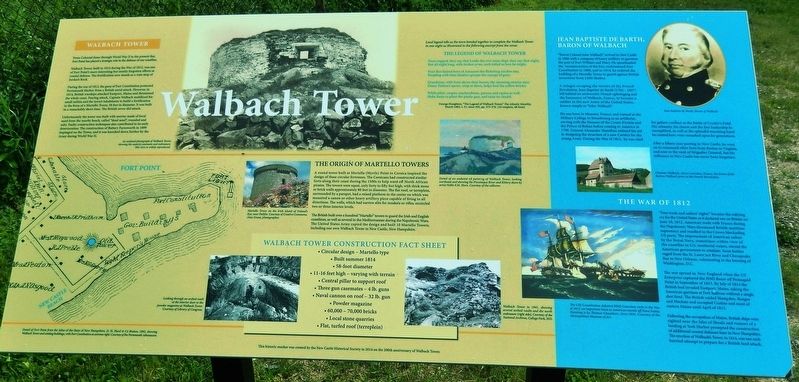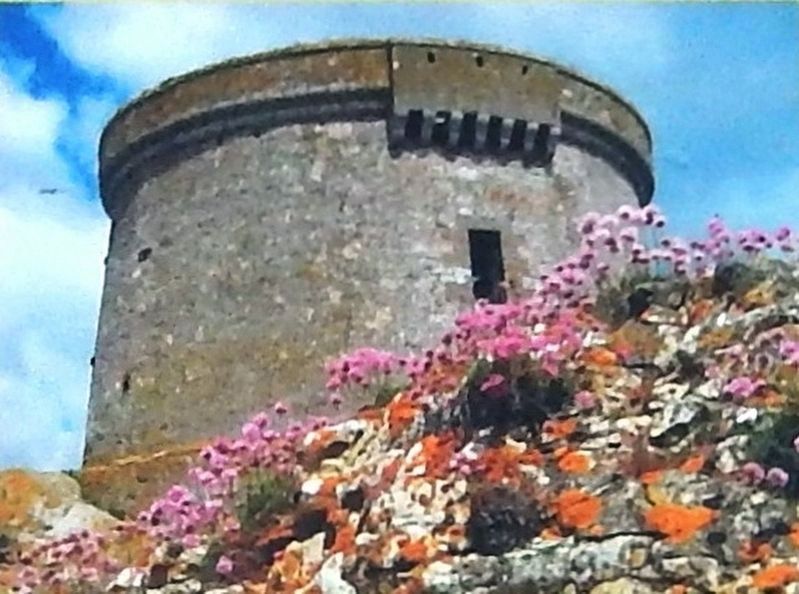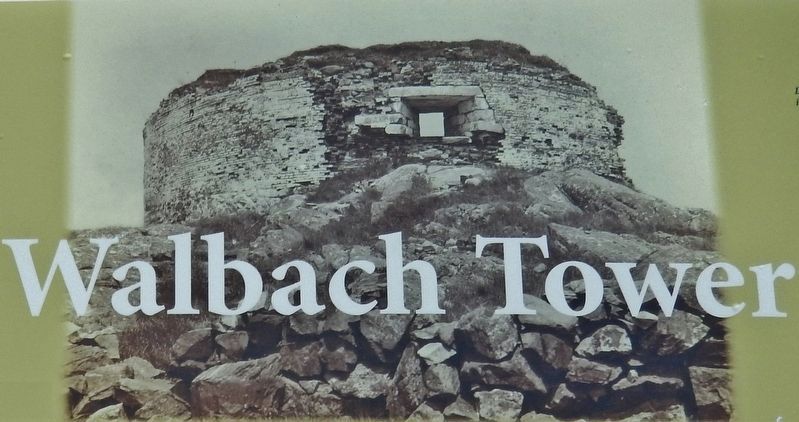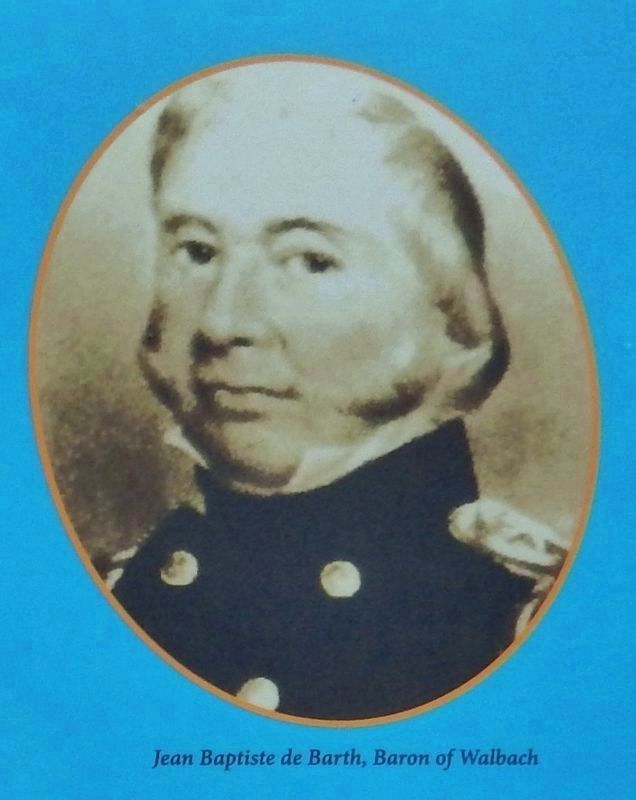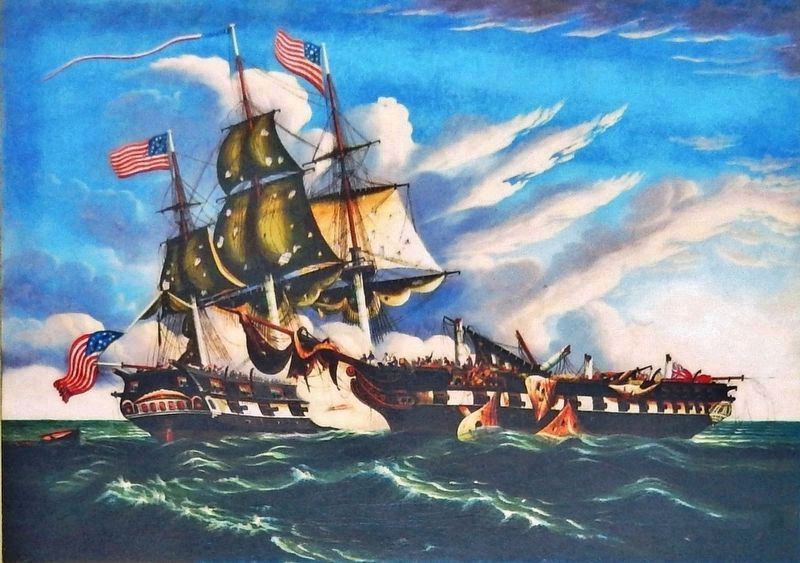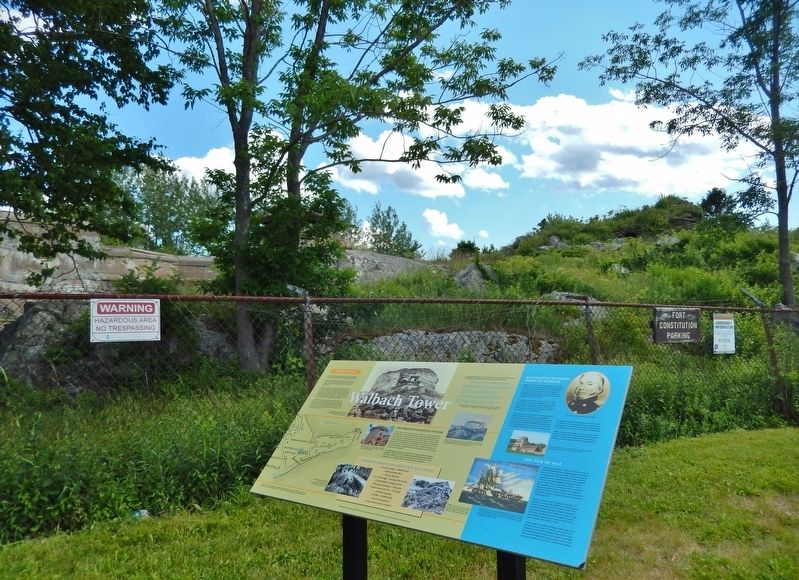New Castle in Rockingham County, New Hampshire — The American Northeast (New England)
Walbach Tower
From Colonial times through World War II to the present day, Fort Point has played a strategic role in the defense of our coastline.
Walbach Tower, built in 1814 during the War of 1812, was one of Fort Point's more interesting but mostly forgotten efforts at coastal defense. The fortification now stands as a ruin atop of Jordan’s Rock.
During the war of 1812, the guns of Fort Constitution protected Portsmouth Harbor from a British naval attack. However, in 1814, British warships attacked Eastport, Maine and threatened the whole coast. Fearing attack, Captain Walbach mobilized his small militia and the town's inhabitants to build a fortification in the form of a Martello Tower, 58 feet in diameter. It was built in a remarkably short time. The British never did attack.
Unfortunately the tower was built with mortar made of local sand from the nearby beach, called "dead sand,” rounded and salty. Faulty construction techniques also contributed to its early deterioration. The construction of Battery Farnsworth in 1899 impinged on the Tower, and it was knocked down further by the Army during World War II.
The Origin of Martello Towers
A round tower built at Mortella (Myrtle) Point in Corsica inspired the design of these circular fortresses. The Corsicans had constructed similar forts along their coast during the 1500s to help ward off North African pirates. The towers were squat, only forty to fifty feet high, with thick stone or brick walls approximately 80 feet in diameter. The flat roof, or terreplein, surrounded by a parapet, had a raised platform in the center on which was mounted a canon or other heavy artillery piece capable of firing in all directions. The walls, which had narrow slits for muskets or rifles, encircled two or three interior levels.
The British built over a hundred "Martello" towers to guard the Irish and English coastlines, as well as several in the Mediterranean during the Napoleonic Wars. The United States Army copied the design and built 10 Martello Towers, including our own Walbach Tower in New Castle, New Hampshire.
• Circular design - Martello type • Built summer 1814 • 58-foot diameter
• 11-16 feet high - varying with terrain • Central pillar to support roof
• Three gun casemates - 4 lb. guns • Naval cannon on roof - 32 lb. gun
• Powder magazine • 60,000 - 70,000 bricks • Local stone quarries • Flat, turfed roof (terreplein)
Local legend tells us the town banded together to complete the Walbach Tower in one night as illustrated In the following excerpt from the verse:
The Legend of Walbach Tower
None supped,
they say, that Lords-day eve; none slept, they say, that night.
But all night long, with tireless arms, each toiled as best he might.
Four flax-haired boys of Amazeen the flickering torches stay,
Peopling with titan shadow groups the canopy of gray;
Grandsires, with frost above their brows, the steaming mortar mix;
Dame Tarlton’s apron, crisp at dawn, helps hod the yellow bricks.
While pilot, cooper, mackerelman, parson and squire as well,
Make haste to plant the pintle-gun, and raise its citadel.
George Houghton, “The Legend of Walbach Tower,” The Atlantic Monthly,
March 1883, v. 51, Issue 305, pp. 375-376. [24 couplets. 48 lines]
Jean Baptiste de Barth, Baron of Walbach
"Brevet Colonel John Walbach" arrived in New Castle in 1806 with a company of heavy artillery to garrison the post of Fort William and Mary. He spearheaded the reconstruction of the fort, rechristened Fort Constitution in 1808, and in 1814, he ordered the building of a Martello Tower to guard against British incursions from Little Harbor.
A refugee escaping the terrors of the French Revolution, Jean Baptiste de Barth (1766 - 1857) left behind an aristocratic French upbringing and the baronetcy of Walbach, France, to become a soldier in the new Army of the United States, known simply as "John Walbach".
He
was born in Munster, France, and trained at the Military College in Strassbourg as an artillerist, serving with the Hussars of the Count d'Artois and the Prince of Rohan before coming to America in 1798. General Alexander Hamilton enlisted his aid in designing the structure of a new Cavalry for the young Army. During the War of 1812, he was cited for gallant conduct at the Battle of Crysler's Field. His urbanity, his charm and the fine leadership he exemplified, as well as the splendid marching band he created here, were remarked upon for generations.
After a fifteen year posting in New Castle, he went on to command other forts from Boston to Virginia, and rose to the rank of Brigadier General, but his influence in New Castle has never been forgotten.
The War of 1812
"Free trade and sailors' rights" became the rallying cry for the United States as it declared war on Britain on June 18, 1812. American trade with France during the Napoleonic Wars threatened British maritime supremacy and resulted in the Crown blockading US ports. The impressment of American sailors by the Royal Navy, sometimes within view of the coastline in U.S. territorial waters, stirred the American government to retaliate. Soon battles raged from the St. Lawrence River and Chesapeake Bay to New Orleans, culminating in the burning of Washington, D.C.
The war spread to New England when the US Enterprise captured the HMS Boxer off Pemaquid Point in September of 1813. By July of 1814 the British had invaded Eastport, Maine, taking the American garrison at Fort Sullivan without a single shot fired. The British raided Hampden, Bangor and Machais and occupied Castine and most of eastern Maine until April of 1815.
Following the occupation of Maine, British ships were sighted near the Isles of Shoals and rumors of a landing at York Harbor prompted the construction of additional coastal defenses here in New Hampshire. The erection of Walbach's Tower, in 1814, was one such hurried attempt to prepare for a British land attack.
(photo captions)
• Looking through an arched vault at the interior door to the powder magazine at Walbach Tower. (Courtesy of Library of Congress)
• Detail of an undated oil painting of Walbach Tower, looking northeast and showing the Piscataqua River and Kittery shore by artist Nellie F.M. Horn. (Courtesy of the collector)
• Chateau Walbach, Alsace Lorraine, France, the home of the Barons Walbach prior to the French Revolution.’
• Walbach Tower in 1941, showing several arched vaults and the north embrasure (right side). (Courtesy of the National Archives, College Park, MD.)
• Detail of Fort Point from the Atlas of the State of New Hampshire, D. H. Hurd & Co. Boston,
1892, showing Walbach Tower and existing buildings, with Fort Constitution at extreme right. (Courtesy of the Portsmouth Athenaeum.)
Erected 2014 by New Castle Historical Society.
Topics. This historical marker is listed in these topic lists: Forts and Castles • War of 1812 • War, World II • Waterways & Vessels. A significant historical year for this entry is 1814.
Location. 43° 4.244′ N, 70° 42.714′ W. Marker is in New Castle, New Hampshire, in Rockingham County. Marker is on Sullivan Lane east of Wentworth Road, on the right when traveling east. Marker is located beside the Fort Constitution parking lot, east of Judd Gregg Marine Research Center, overlooking the subject Walbach Tower ruins. Touch for map. Marker is at or near this postal address: 29 Wentworth Road, New Castle NH 03854, United States of America. Touch for directions.
Other nearby markers. At least 8 other markers are within walking distance of this marker. A different marker also named Walbach Tower (a few steps from this marker); Portcullis (about 600 feet away, measured in a direct line); Fort William and Mary Commemoration Marker (about 600 feet away); William and Mary Raids (about 600 feet away); Mines Building
(approx. 0.2 miles away); Frost Cemetery (approx. 0.2 miles away); New Castle Congregational Church (approx. ¼ mile away); Resisting Naval Firepower (approx. ¾ mile away in Maine). Touch for a list and map of all markers in New Castle.
Related markers. Click here for a list of markers that are related to this marker. Walbach Tower
Credits. This page was last revised on December 23, 2020. It was originally submitted on June 15, 2019, by Cosmos Mariner of Cape Canaveral, Florida. This page has been viewed 470 times since then and 56 times this year. Photos: 1, 2, 3, 4, 5, 6. submitted on June 15, 2019, by Cosmos Mariner of Cape Canaveral, Florida.
